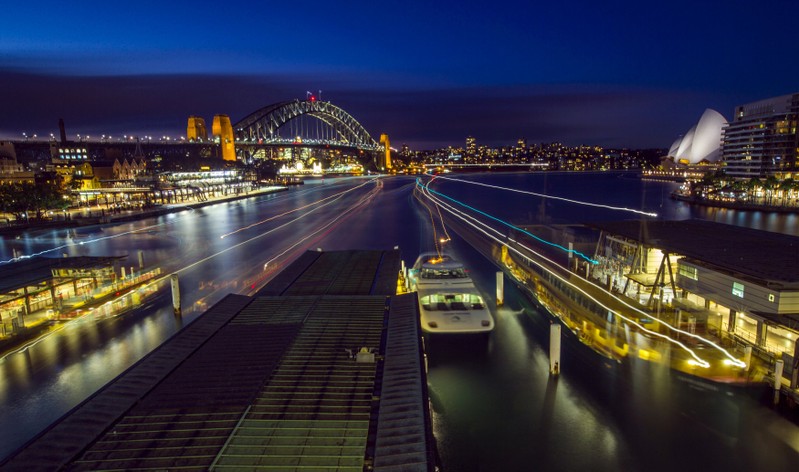
FILE PHOTO: Streaks of light from arriving ferries illuminate wharves at Sydney’s Circular Quay terminal in this seven-minute-long time exposure at dusk, July 16, 2015. REUTERS/Jason Reed/File Photo
June 5, 2018
By Swati Pandey
SYDNEY (Reuters) – A bumper run of resource exports and higher government spending provided a much-needed fillip to Australia’s economy last quarter, supporting views the economy is likely to extend its 26-year run without recession.
Figures from the Australian Bureau of Statistics (ABS) on Tuesday showed government spending climbed 1.6 percent in the first quarter to an inflation-adjusted A$84.6 billion $64.7 billion), lifting potential for growth.
Separate data showed stronger exports and a relatively smaller rise in imports combined to add 0.3 percentage points to gross domestic product (GDP) last quarter. Analysts had predicted a 0.5 percentage point addition.
The jump in goods exports helped narrow the country’s current account deficit to the smallest since early 2017 at A$10.5 billion.
The strong numbers prompted analysts to upgrade their GDP forecasts. Data due Wednesday is likely to show Australia’s A$1.8 trillion expanded 0.9 percent in the first quarter from a tepid 0.4 percent in December. [ECONAU]
The annual pace likely accelerated to a healthy 2.8 percent, from 2.4 percent the previous quarter.
Economists had earlier expected growth of 0.8 percent for the quarter and 2.7 percent for the year.
The Reserve Bank of Australia (RBA) has recently sounded upbeat about economic activity, thanks in part to unexpected strength in the domestic labor market and a synchronized upturn in global growth.
However, consumer spending — which accounts for around 57 percent of GDP — has cast a shadow over the RBA’s optimism.
That is one reason the central bank is considered certain to leave interest rates at an all-time low 1.50 percent for the 22nd straight meeting later in the day. [AU/INT]
Interest rates have been on hold since August 2016, marking the longest period of unchanged policy since the cash rate was introduced in 1990. The futures market <0#YIB:> is not fully pricing in a hike until September next year.
“Net exports contribution came in below consensus, but is still quite strong compared with the negative drag on GDP we saw in the December quarter,” said JPMorgan economist Henry St John.
“The government finance numbers were stronger than we had expected. Consumption growth continues to weaken in a fairly orderly manner. So we have to rely on trade numbers for GDP growth.”
While strength in retail and car sales in the first quarter suggest consumption made a reasonable contribution to overall activity, data out on Tuesday showed that momentum has faded.
New vehicle sales slipped in May for the second straight month as demand for light commercial vehicles and passenger cars declined.
Retail sales growth in April was a tepid 0.4 percent after a flat March.
(Reporting by Swati Pandey; Editing by Sam Holmes)

